| Area |
Basinwide |
| Topic |
Tour: Navarro River Historical Photos, Part 1 |
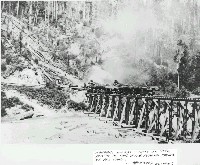 Click on image to enlarge (113K).
Click on image to enlarge (113K).The photo shows the Navarro Woods, June 21, 1890. The engine (no cab) is loaded with log cars. Notice the cleared hillside in the background. The stream channels is littered with log butts suggesting that they may have been transported by floating during high flows. Transporting logs in stream channels often involved augmenting flows with splash dams (see Picture #4). Photo provided courtesy of the Held-Poage Memorial Home and Mendocino Historical Society, Ukiah, California, from the Robert Lee Collection.
L-#03404 Escola.
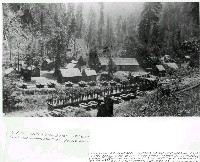 Click on image to enlarge (122K).
Click on image to enlarge (122K).The photo shows an overview of Navarro Woods Camp, probably near Hop Flat, where lumbermen slept and ate. The crew is posed on flatcars that would normally carry logs or lumber with Locomotive 0-4-0 attached. Far Locomotive 2-4-4T "H. B. Tichenor," was built in 1888. Photo provided courtesy of the Held-Poage Memorial Home and Mendocino Historical Society, Ukiah, California, from the Robert Lee Collection. Gilfillan photo L-#05492 Ginsburg.
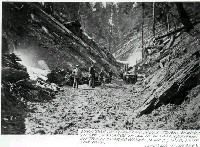 Click on image to enlarge (75K).
Click on image to enlarge (75K).The photo caption reads "Visitors inspecting a bull team working in the Navarro Mill Co. Woods, upstream on the Navarro River on June 21, 1890. Note the mud." In fact, this photo is likely somewhere in the lower Navarro or in the North Fork. The use of the stream course as a skid trail would have caused a major contribution of sediment to streams below during storm events. While this may have been one of the most intensive land management eras in the Navarro basin, the extent of areas disturbed was substantially less than in the Post WW II period. Photo provided courtesy of the Held-Poage Memorial Home and Mendocino Historical Society, Ukiah, California, from the Robert Lee Collection. L-08240, Nichols.
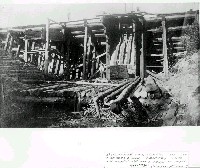 Click on image to enlarge (56K). Click here to display a larger version (222K).
Click on image to enlarge (56K). Click here to display a larger version (222K).This photo shows splash dam construction on the Navarro River used in driving logs to mill. Splash dams would pond water behind them which would be released during storm events to create artificial floods to float logs downstream to the mill. These high flows scoured channels and greatly simplified aquatic habitat, sometimes with long lasting and profound consequences for fisheries productivity. Photo provided courtesy of the Held-Poage Memorial Home and Mendocino Historical Society, Ukiah, California, from the Robert Lee Collection. #03399, Georgia Pacific Lumber Company.
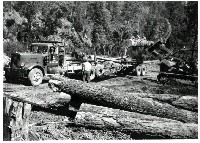 Click on image to enlarge (81K).
Click on image to enlarge (81K).This photo shows the type of logging equipment used in the period after World War II. With heavy equipment like loader at right and caterpillar tractors to build roads on steep slopes, logging took place in areas formerly inaccessible. The caption on the photo read: "Darwin Christiansen log show west of Anderson Brothers. Loading Al Stinson's Autocar with a 966 loader. Garcia 1962." Photos provided courtesy of the Held-Poage Memorial Home and Mendocino Historical Society, Ukiah, California, from the Robert Lee Collection.
L-#08580, Lee.
To learn more about this topic click Info Links
To view additional information (data source, aquisition date etc.) about this page, click Metadata
 Click on image to enlarge (113K).
Click on image to enlarge (113K). Click on image to enlarge (122K).
Click on image to enlarge (122K). Click on image to enlarge (75K).
Click on image to enlarge (75K). Click on image to enlarge (56K). Click here to display a larger version (222K).
Click on image to enlarge (56K). Click here to display a larger version (222K). Click on image to enlarge (81K).
Click on image to enlarge (81K).